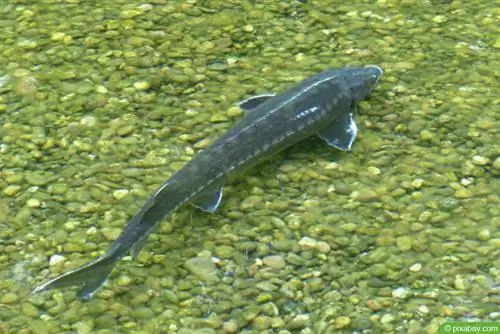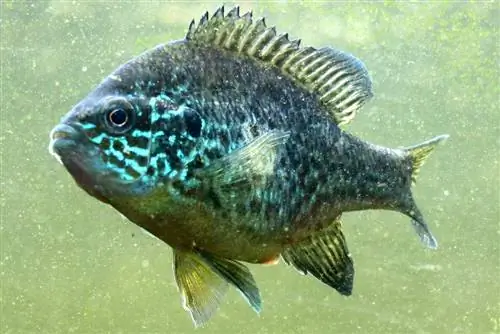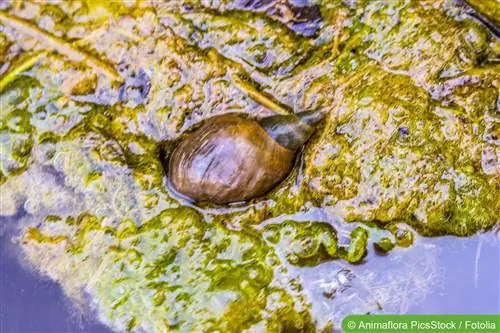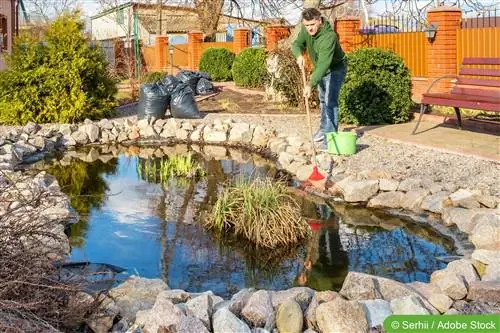- Author admin [email protected].
- Public 2023-12-17 03:39.
- Last modified 2025-01-24 12:45.
Sturgeons, also known biologically as Acipenseridae, are considered ancient bony fish and almost living fossils. For this reason and because of their striking appearance, many hobby gardeners want a specimen in their ornamental pond at home. With us you will find numerous tips and suggestions on how to properly keep animals in the pond. The sturgeon develops best and most permanently in the pond when the living conditions created there are as close as possible to its natural habitat. To achieve this, you should consider the following things:
The species of sturgeon
A total of around 26 species of sturgeon are known. However, only a few species are suitable for keeping in ponds. The decisive factor here is on the one hand the size, but on the other hand also the eating behavior. Large animals with body lengths over 2.00 meters hardly find enough space in the garden pond to develop undisturbed. Plankton-eating species, such as the North American paddle sturgeon or the lake sturgeon, would simply starve to death in the limited pond volume due to a lack of food.
Popular sturgeon species for pond keeping are:
- Sterlet, body length up to approx. 1.50m, weight up to approx. 10 kg
- Sternhausen (Acipenser Stellatur), length up to 1.50m, weight up to approx. 25 kg
- Güldenstadi (Acipenser Güldenstaedtii), length up to 2.00m, weight up to approx. 80 kg
- Waxdick (comparable to Güldenstadi)
- Siberian sturgeon (Acipenser baerii), length up to 2.00m, weight up to approx. 100 kg
- Diamond Sturgeon (cross between Sterlet and Waxdick)
The pelvic volume
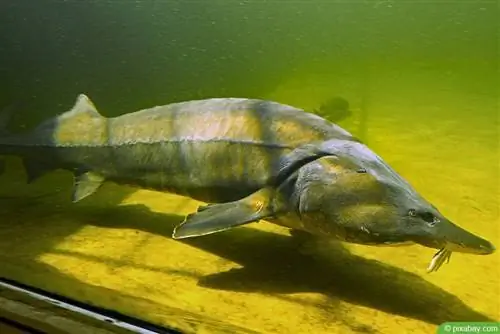
The sturgeon is a frequent swimmer and needs space to do so. Therefore, a pond should adhere to certain minimum dimensions in terms of size and depth:
- Maximum depth at least 1, 50 to 2, 00 meters
- Length of this deep water zone at least 12 times the adult body length (corresponds to the escape distance of the sturgeon)
- Deep water area, depending on the type of sturgeon, approx. 12 to approx. 20 meters (!!) long
- Minimum pond volume per animal at least 1,000 liters
ATTENTION:
We read again and again that the sturgeons grow in size based on the pond available and may only reach smaller body sizes. However, that is not true! In a tank that is too small, a sturgeon never reaches its full size because it does not reach its full potential due to poor living conditions.
The current
As an active animal, sturgeons prefer rivers with moderate to even strong currents. Especially in very limited garden pond volumes, a flow pump should ensure movement in the water. This way you can imitate running water. The animals also have the opportunity to feel like they can extend the distance they swam against the current despite the small size of the pond.
The water quality
The sturgeon is used to very high water quality with the following properties in its natural habitat:
- High oxygen content (can be achieved through good ventilation or circulation pump)
- Good soil drainage (through appropriate circulation) for sufficient oxygen in the deeper water layers of the pond (=popular habitation zone for the sturgeon)
- Low water temperature up to a maximum of 20 degrees Celsius (ensure large volume and good ventilation)
- Low level of contamination (to be ensured by a sufficiently dimensioned filter system)
NOTE:
If the pond water deviates from the optimal parameters, the sturgeon, which is insensitive, can also deal with it. However, as its suitability for water decreases, it will suffer more and more and its development will primarily be inhibited. In addition, the risk of illness or parasite infestation increases because, unlike sturgeon, the pathogens value warm water with a high nutrient content.
The pond shape
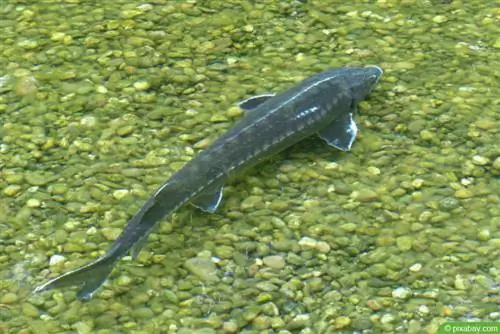
The sturgeon often stays at the bottom of the water, where it uses its long snout to dig in the soft bottom for mussels, snails and worms. A classic koi pond with steeply sloping side walls would therefore mean that the sturgeon stays mainly at the bottom of the pond and is hardly visible. A terraced pond with different flat or inclined levels is therefore better. To do this, the already mentioned base layer of pond soil or clay should be applied to the bottom. The sturgeon, on the other hand, doesn't like gravel or sand at all, as its robust-looking snout is surprisingly sensitive to sharp stones or sharp edges.
The planting
As is usual in current waters, sturgeons prefer loose vegetation that they can easily swim through. Thread algae in particular is considered the sturgeon's enemy, as it easily gets tangled up in it when it is young and cannot yet free itself on its own. As a result, the captured animal dies. It is therefore important for the vegetation:
- Keep vegetation to a minimum
- Lighten if necessary
- Check and remove thread algae regularly
- Keep water quality high to limit excessive development of algae etc.
ATTENTION:
Like other current fish, the sturgeon cannot swim backwards. Once he is trapped in filamentous algae, there is no way out for him. It is therefore worth taking a regular look at your own pond so that you can intervene if necessary.
Society
A sturgeon can be easily socialized with other animals if the pond is large enough. Attacks on other animals by the sturgeon are hardly known. However, care should then be taken to select the pond volume so that sufficient space and suitable environmental areas are created for all species and individuals used.
The only thing that can be critical when keeping animals together is feeding. Since the sturgeon is considered an extremely slow eater, young animals can starve to death in extreme cases if koi and other inhabitants literally snatch the food from under their noses. Feeding when kept together is also quite easy and easy:
- Feed disturbers regularly at the same time and in the same place, as a result of which the animals get used to it and find the food more quickly
- Distract roommates by giving food elsewhere at the same time
- Use individual food for each species of fish to promote separation
The food
With the exception of a few plankton eaters, which are unsuitable for keeping ponds, sturgeons feed on animal food:
- worms
- insect larvae
- Aquatic animals, such as snails or mussels
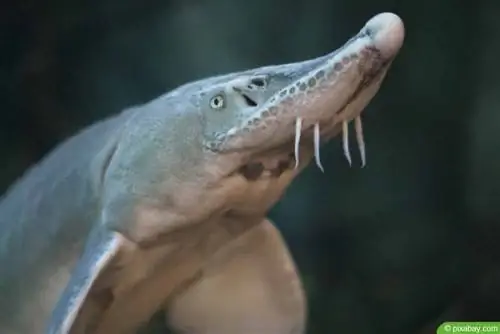
But classic trout food is also suitable for feeding. What is important is a high energy content, i.e. food rich in fat and protein. This gives the animals the energy they need for intensive swimming.
- Optimal feeding time from around 6 p.m., as the animals' activity is most intense in the evening
- Establish a regular feeding spot for easy finding of food
- Use sinking food as an incentive for the species' natural feeding process
- In winter, also use sinking food, as when temperatures drop, people prefer to stay at the bottom of the pond
- From water temperatures of six degrees Celsius and below, reduce food, as animals then reduce activities and become paralyzed with cold
Illness prevention
Sturgeons are generally considered to be very robust and resilient animals. However, it can still happen that they are attacked by parasites or diseases. Once it has gotten to this point, you should definitely consult a qualified veterinarian. However, there are a lot of things you can do yourself when it comes to preventing illness:
- Ensure high water quality with low temperatures and low levels of dirt in order to contain the proliferation of pathogens
- Check animals regularly for skin changes or adherent parasites (e.g. roundworms)
- Observe the behavior of the animals, as behavioral changes are usually the result of illness or weakening of the sturgeon
- If there are any noticeable changes, consult a veterinarian
The Multiplication
Finally, for the sake of completeness, the topic of the reproduction of sturgeons in the pond should be briefly addressed. Since the animals get very old and only reach sexual maturity after up to 8 years, targeted breeding in your own pond is usually difficult. Mating can also hardly be actively promoted. If there are enough males and females of mating age, the only way to increase the likelihood that the animals will feel comfortable and start reproducing on their own is to provide the best possible habitat. Be sure that if the time comes, you have helped to preserve these highly endangered animals in your garden pond to some extent.


